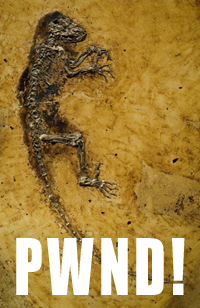 Before January is over, and it's still justifiable to review the year that has passed, I wanted to comment on the biggest scientific hullabaloo of the last year. Of course it could only be Ida, the ONE fossil, or Darwinius masillae.
Before January is over, and it's still justifiable to review the year that has passed, I wanted to comment on the biggest scientific hullabaloo of the last year. Of course it could only be Ida, the ONE fossil, or Darwinius masillae. An article came out in Nature last October refuting the claim that Darwinius was the "earliest human ancestor". The team of researchers, fronted by Eric Seiffert, present the analysis of a new exciting primate fossil called Afradapis longicristatus, a relative of Darwinius separated by around 10 million years, and re-analyze the family tree of the primates to show that both Darwinius and Afradapis belonged to a very diverse group of early primates that left no descendants. The likeness in some features to anthropoids (monkeys and apes) is probably due to convergent evolution rather than relatedness.
You can read more extensive comments on the scientific findings in entries by sciencebloggers Brian Switek and Ed Yong - Afradapis and "Ida", sittin' in a tree, Breaking the Link - Darwinius revealed as ancestor of nothing. There is also a popular science write-up and a Q&A with Eric Seiffert at Times Online.
Q: The paper suggests that adapids such as Afradapis and Darwinius are likely members of a branch that died out, rather than the ancestors of anthropoids. Could you briefly summarise what leads you to this conclusion?
Erik Seiffert: In order to test the different ideas that have been proposed about which fossil primate groups gave rise to monkeys, apes, and humans (Anthropoidea), we compiled a large dataset of anatomical observations, made across 117 living and extinct primates -- including all of the fossil primates that have been proposed as possible early members of the anthropoid group.
We used a computer program to find the primate family tree that provides the simplest explanation for the distribution of these traits. In that tree, adapiform primates like Darwinius and Afradapis are not placed close to higher primates, but rather are situated as closer relatives of the living lemurs and lorises, which are "prosimian" primates.
Q: What does this tell us about the claims made for Darwinius as a putative ancestor of higher primates?
ES: Our analysis provides no support for the claim that Darwinius is a link in the origin of higher primates, and instead indicates that, if anything, Darwinius is more relevant for our understanding of the origin of lemurs and lorises -- which are our most distant primate relatives.
This article also shows exactly how the publication and announcement of scientific findings should be done - it's a measured approach, without hoopla and with consistency and honesty. Without hyperbolic multimedia tie-ins and misleading websites.
This paper, regardless of the importance of the findings compared to the Darwinius publication, I'm sure will be much more appreciated and valued by the field. The sad thing is that the public will likely be a lot more aware of "Ida" than of its far more reasonable cousin.
Seiffert, E., Perry, J., Simons, E., & Boyer, D. (2009). Convergent evolution of anthropoid-like adaptations in Eocene adapiform primates Nature, 461 (7267), 1118-1121 DOI: 10.1038/nature08429
Swedish blog tags: Vetenskap, Evolution, Paleontologi, Neurovetenskap, Darwinius
Technorati tags: Science, Evolution, Paleontology, Fossil, Darwinius, Afradapis
No comments:
Post a Comment
Note: Only a member of this blog may post a comment.